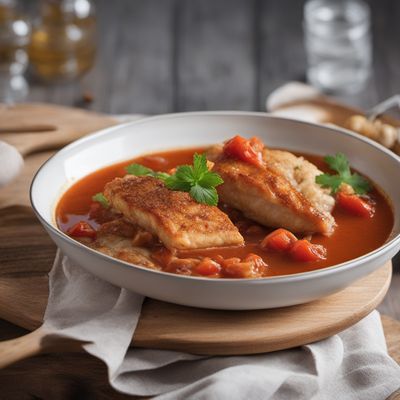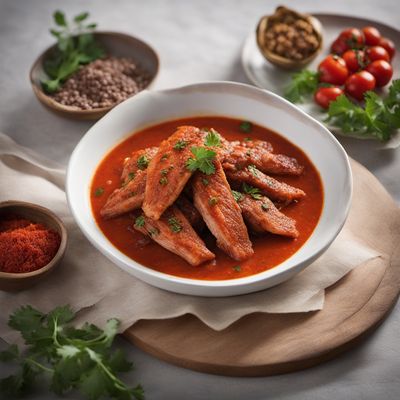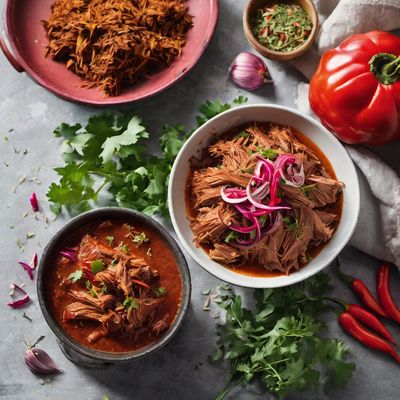
Ingredient
Hungarian-type salami
"The Bold and Savory Delight: Exploring Hungarian-style Salami"
Hungarian-type salami is a dry-cured sausage made from high-quality pork, seasoned with a distinctive combination of spices such as paprika, garlic, and black pepper. It is characterized by its deep red color, coarse texture, and a complex flavor profile that ranges from mildly spicy to robust and smoky. The salami is typically encased in a natural casing and undergoes a slow aging process, resulting in a firm texture and intense flavor.
Origins and history
Hungarian-type salami has its roots in Hungary, where it has been a beloved culinary tradition for centuries. The art of salami-making was introduced to Hungary by the Turks during the Ottoman Empire. Over time, Hungarian salami evolved to incorporate local ingredients and flavors, becoming an integral part of Hungarian cuisine. Today, it is renowned worldwide for its exceptional quality and taste.
Nutritional information
Hungarian-type salami is a good source of protein and essential vitamins and minerals. It is also high in fat and calories, so moderation is key. A 1-ounce serving of Hungarian-type salami provides approximately 120 calories, 10 grams of fat, and 6 grams of protein.
Allergens
Hungarian-type salami may contain allergens such as pork and spices. Individuals with pork or spice allergies should exercise caution when consuming this ingredient.
How to select
When selecting Hungarian-type salami, look for a well-aged salami with a firm texture and a deep red color. Avoid salamis that appear overly soft or have a slimy surface. Opt for salamis that are made from high-quality pork and have a balanced distribution of fat throughout.
Storage recommendations
To maintain the freshness and quality of Hungarian-type salami, store it in a cool, dry place. Once opened, wrap the salami tightly in plastic wrap or butcher paper and refrigerate. Properly stored, it can last for several weeks. For longer-term storage, Hungarian-type salami can be frozen, but it may slightly alter the texture.
How to produce
Producing Hungarian-type salami at home requires expertise and specialized equipment. It involves grinding high-quality pork, mixing it with spices, stuffing the mixture into casings, and then undergoing a controlled fermentation and aging process. It is recommended to seek guidance from experienced salami makers or charcuterie experts if attempting to produce it at home.
Preparation tips
Hungarian-type salami is typically enjoyed sliced thinly and served as part of a charcuterie board, sandwich, or pizza topping. It can also be incorporated into various dishes, such as stews, pasta sauces, or omelets, to add depth of flavor. When using Hungarian-type salami in cooking, it is best to add it towards the end of the cooking process to preserve its texture and flavor.
Culinary uses
Hungarian-type salami is a versatile ingredient that adds a bold and savory flavor to a wide range of dishes. It is commonly used in Hungarian cuisine, such as in goulash, Hungarian sausages, or as a topping for langos (Hungarian fried bread). It can also be enjoyed on its own as a snack or paired with cheese, bread, and pickles on a charcuterie platter.
Availability
Hungarian-type salami is commonly available in Hungary and can be found in specialty stores or delis that offer international or European food products. It is also exported to various countries, particularly those with a significant Hungarian population or a strong appreciation for Hungarian cuisine.
More ingredients from this category
Recipes using Hungarian-type salami » Browse all

Harcsapaprikás with Nokedli (Hungarian Paprika Catfish with Dumplings)
Spicy Hungarian Delight: Harcsapaprikás with Homemade Dumplings

Hungarian-style Paella
Magyar Paella: A Hungarian Twist on a Spanish Classic

Hungarian-style Gyoza
Magyar Gyoza: A Hungarian Twist on a Japanese Classic

Hungarian Paprika Beef Stew
Savory Hungarian Paprika Beef Stew: A Hearty Delight

Creamy Hungarian Potato Stew
Velvety Paprika Infused Potato Delight

Gundel Salad with Walnut Dressing
Savory Delight: A Twist on Hungarian Gundel Salad

Jókai Bean Soup
Hearty Hungarian Delight: Jókai Bean Soup

Hungarian-style Tapas
Magyar Munchies: A Taste of Hungary in Tapas Form

Harcsapaprikás with Seswaa: A Fusion of Hungarian and Botswana Flavors
Spicy Catfish Stew with Seswaa: A Taste of Hungary and Botswana in Every Bite

Cochinita Pibil - Hungarian Style
Hungarian-Inspired Slow-Roasted Pork with Aromatic Spices

Pacalpörkölt with Hungarian Paprika Sauce
Savory Delight: Pacalpörkölt - A Hungarian Paprika Infused Dish

Hungarian Mohnkuchen
Poppy Seed Delight: Hungarian Mohnkuchen Recipe